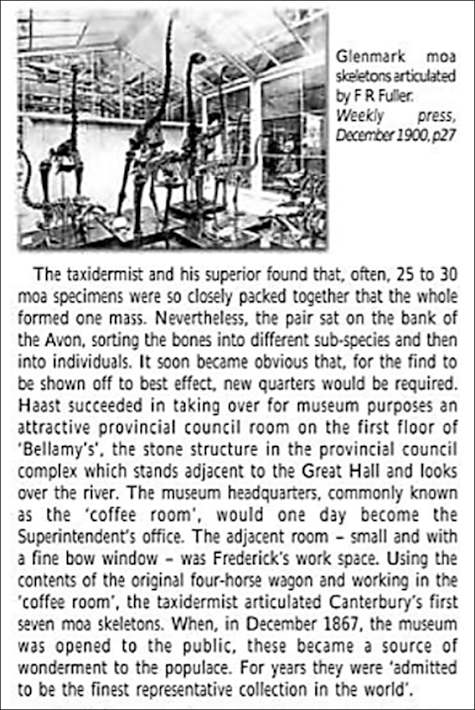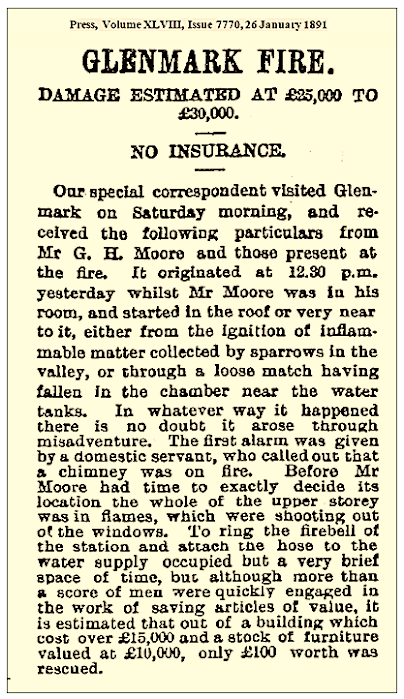NEW ZEALAND
GLENMARK HOUSE AND SHEEP RUN
PORTER’S PASS * SPRINGFIELD STAGECOACH AT GLACIER HOTEL
collected during his three year-long Grand World Tour 1892-1895.
DEVIL’S PUNCH
BOWL BEALEY, CASTLE HILL.
.
Written from first-hand research by George W. Randall, co-founder in July 1996 and
former Vice Chairman Kinloch Castle Friends' Association.
Late 19th Century photographs from the albums of George Bullough, collected during his three year-long Grand World Tour 1892-1895.
B L O G 7 5 * ALBUM XII
*<>*<>* Time of George Bullough's visit to New Zealand November 1894. *<>*<>*

| FINE
EXAMPLE OF A NEW ZEALAND RESIDENCE (Glenmark) Album XII * Image 1 * Detail from full size 8½ x 6 inches. Single photograph of Glenmark from Album XII in the Library at Kinloch Castle former Highland home of Sir George and Lady Bullough. |


↑ Conservatory built on curtain wall.
THE AUTHOR - GEORGE W. RANDALL:
THANK YOU!
>+< >+< >+< > + < >+< >+< >+<
GLENMARK
GLENMARK
FINE EXAMPLE OF A NEW ZEALAND RESIDENCE
*<>*<>*<>*< >*<>*<>*<>*<>* *<>*<>*<>*<>*< >*<>*<>*<>*
 |
FINE EXAMPLE OF A NEW ZEALAND RESIDENCE
Album XII * Image 1 * Detail from full size 8½ x 6 inches. |
 |
| The twenty albums contain around seven hundred images of the places visited in the closing decade of the nineteenth century. |
* >< * * >< * * >< * * >< *
*<>*<>*<>*< >*<>*<>*<>*<>* *<>*<>*<>*<>*< >*<>*<>*<>*
We are beginning Blog 75 with
ALBUM XII - NEW ZEALAND
We are beginning Blog 75 with
ALBUM XII - NEW ZEALAND
 |
* >< * * >< * * >< * * >< *
* >< * * >< * * >< * * >< * * >< * * >< * * >< * * >< *
GLENMARK - “A
Fine Example of a New Zealand Residence.”
Glenmark house “stood
in the midst of beautifully laid out gardens.”
Taking seven years to construct it was designed by Samuel Charles Farr utilising concrete, a technological innovation at the time. The height of the house “was about thirty-five feet, the rooms on the basement (ground) and upper floor were fifteen feet floor to the ceiling.”
Taking seven years to construct it was designed by Samuel Charles Farr utilising concrete, a technological innovation at the time. The height of the house “was about thirty-five feet, the rooms on the basement (ground) and upper floor were fifteen feet floor to the ceiling.”
“The furniture, much of it especially
imported from England, along with the fittings were described as being “sumptuous”,
their cost, according to the report in The Star of 24th of January
1891 to be “no less a sum than £11,000.”
“Each room had its elaborate fittings, from
costly white marble mantelpieces to ornamental ceilings with unique cornices
and centre ornaments of elegant designs, dadoings, friezes and borders
producing wonderful contrasts with harmonies of colour.”
Areas of the ground floor were laid with the most intricate tessellated pavement, upstairs being reached by a magnificent marble staircase. Fine paintings and tapestries adorned the walls,
“the proprietor sparing neither money nor trouble to improve his residence.”
>< * * >< * * >< * * >< * * >< * * >< * * >< * * >< * * >< * * ><
SPRINGFIELD COACH, BEALEY, NEW ZEALAND
 | ||||
|
Standing at 2,140
feet above sea level the hotel proprietor in the 1890’s was James O’Malley, an ex-policeman. He moved to the Terminus Hotel - also known as the Otira Hotel - Otira in 1901 to be succeeded by thirty-four year old John Henry Fletcher an-émigré from
Sheffield, England, who had previously been proprietor of a general store in Rangiora about sixteen
miles north of Christchurch.
SPRINGFIELD COACH, BEALEY, NEW ZEALAND J.R. 500 (Glacier Hotel left)
Album XII * Image 2 * Size 8 x 5½ inches. Original photographer James Ring.
Cobb & Co’s stagecoach is photographed on the West Coast Road between Canterbury and Westland at the Glacier Hotel, Bealey, where the horses were changed. THE PHOTOGRAPHER
James Ring was born
in the south London (England) district of Camberwell on the 6th of
April 1856, the youngest son of Harriet and Stephen Ring, a carpenter.
Records state that aged sixteen he was working as an “errand boy” and in the 1870’s
“trained as a photographer with Edward Allen & Frank Rowell, By 1879, aged twenty-three, he is in New Zealand, working in a photographic shop
and described as being “a first class artist with many years’ experience
in London studios.”
James arrived in
Wellington, New Zealand on the 16th of July 1879 after 105 days
Less than four months later, due to ill-health, he moved and settled in the
west-coast town of Greymouth on South Island working in the Mawhera Quay studio of William Herbert Perkins. Here he was able to record the frequent shipwrecks and floods that are very much a part of Greymouth’s history.
In 1881 James Ring took over the business.
On the 17th of April following year, in St. John’s Presbyterian Church, Greymouth, a church he was to be associated with for most of his life, he married Kate Maria Vinsen, “a milliner” originally from Cambridge, England. They had three sons, Leslie, James and Claude.
James undertook
numerous photographic expeditions the resulting images of which he offered for sale and today are an invaluable record of West Coast life in the 1880’s. Although
portrait commissions were the backbone
of Ring’s business, fortunately he foresaw
opportunity in photographing the less favourite, the unfamiliar and spectacular scenes and
events in this new colony. Consequently he built-up an extensive folio of outdoor images; spectacular scenery, gold and coal mining and establishment of new
settlements; “one thousand photographs alone of West Coast scenes”, packs
of “fifty-two of which he offered - post free - to all parts of the world for £2:12:0d.”
or in bound ready-made albums.
At the height of his business he employed eight assistants at his studios in Reefton
and Hokitika as well as Greymouth. Regrettably around 1924 fire destroyed a number of his negatives, after which he amalgamated his business with
Lawrence Andrew Inkster, the firm being known as Ring and
Inkster until his
retirement in 1929 aged seventy-three.
James Ring died
on the 19th of July 1939.
* >< * * >< * * >< * * >< * * >< * * >< * * >< * * >< * * >< * * >< *
* >< * * >< * * >< * * >< * * >< * ++ * >< * * >< * * >< * * >< * * >< *
|




































































































No comments:
Post a Comment